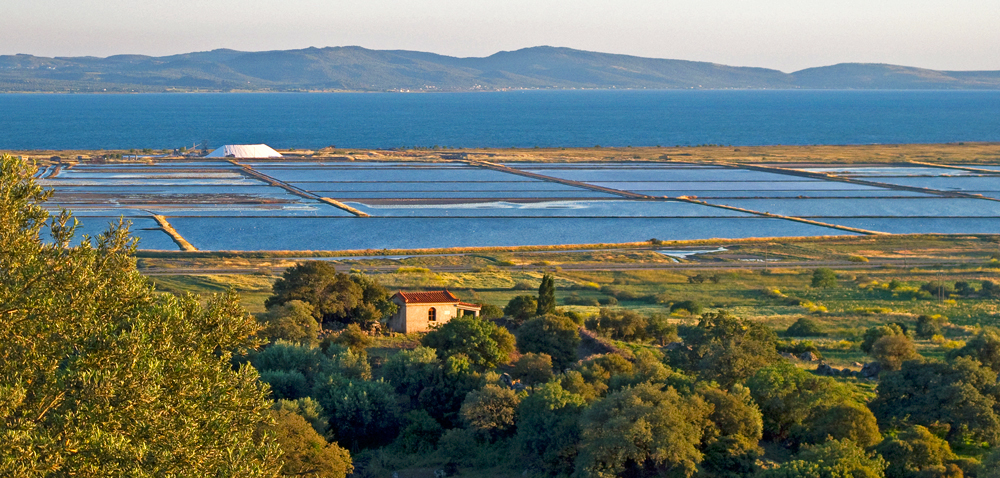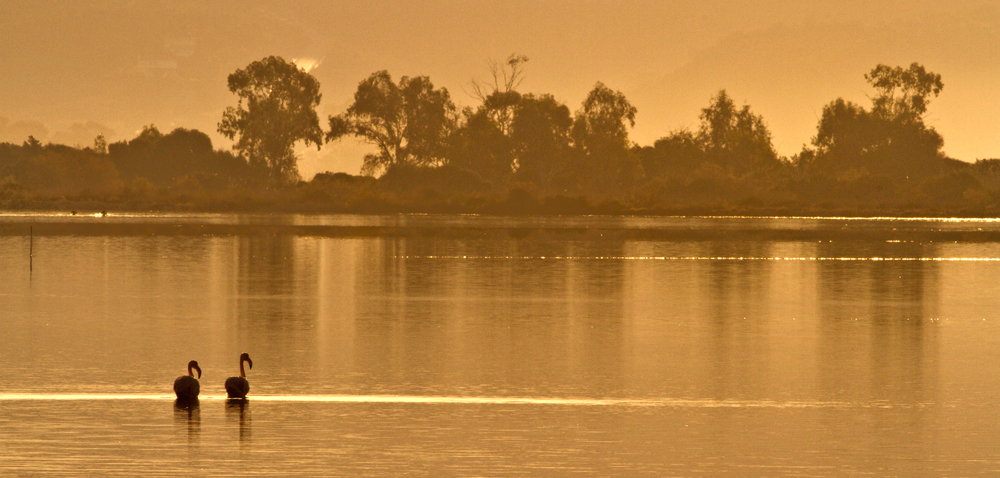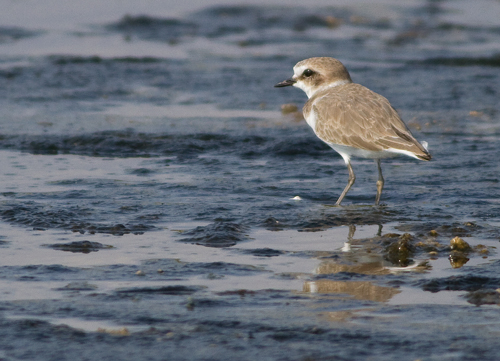Wetlands
Kalloni saltpans

The largest wetland of Lesvos island and one of the most important stations for many wading and aquatic birds in the migratory route of the eastern Aegean. The name “Kalloni” is related to the beauty (“kállos” means beauty in ancient Greek) or, according to another version, comes from the fertile plain of the area (about 100 sq.kilometres) and the combination of the words “kallo-gea” which means “good earth”. Kalloni saltpans (transl. Aliki of Kalloni) is located in the north of the largest gulf of the island, the Gulf of Kalloni, or the ancient Pyreon Evripos. Kalloni gulf is a large semi-enclosed gulf that communicates with the open Aegean sea through a narrow channel of 865 metres. The channel restricts significantly the movement of water masses resulting in the creation of special characteristics inside the gulf, such as bigger salinity from the sea, high productivity and eutrophication. Kalloni saltpans has been created by the silt materials of Tsiknias river and Xynorodos stream. It is an industrial saltpan that spreads to 583 acres, which together with the wetland systems that surround it (wet meadows, salt marshes, reeds, sand dunes, etc.) reaches to 1,137 acres. To the west of Kalloni flows Tsiknias river, to the north lie the small hills Mala, Issa, Kouratsonas and Elafos and to the east Mylopotamos stream separates Kalloni from the large pine forests of central Lesvos. To the south it is separated from the sea by a 2.5 km long and 400 metres wide land strip. The saltpans are surrounded by a 3 km long drainage ditch where the water comes and goes to the sea, leaving behind it about 40,000 tons of salt per year. Kalloni holds the second in production saltpans in Greece. Before the creation the saltpans the whole area was an extensive lagoon. However, despite the transformation of the site from a large natural estuary ecosystem into an artificial wetland, the area still attracts a huge number of bird species. Kalloni is considered one of the most important wetlands of Europe, attracting every year hundreds of birdwatching enthusiasts. Perhaps it is one of the most remarkable examples of ecotourism development in Greece, as the visitors who come to observe birds are present throughout the year.
The vegetation found in the area consists mainly of various aquatic plants together with species adapted to high salinity conditions. Dominant plants close to the saltpans are Halimione portulacoides, Hordeum marinum, Atriplex portulacoides, Halocnemum strobilaceum, Salicornia procumbens, Sarcocornia perennis, Sarcococcus fruticosa, Arthrocnemum macrostachyum, Suaeda maritima, Suaeda splendens, Juncus acutus, Phragmites australis, Alopecurus myosuroides, Bolboschoenus maritimus, Carex divisa, Carex otrubae, Ranunculus peltatus subsp. peltatus and Limonium bellidifollium. Important plants of the surrounding area are Cotula coronopifolia, Andryala integrifolia, Echinops spinosissimus subsp. bithynicus, Myosotis litoralis, Silene subconica, Atriplex davisii, Trifolium glanduliferum, Cicendia filiformis, Sideritis lanata, Papaver virchowii and Papaver nigrotinctum. The vegetation of the area is complemented by species such as Isoetes histrix, Allium amethystinum, Allium pallens, Allium paniculatum subsp. paniculatum, Eryngium creticum, Anthemis tomentosa subsp. tomentosa, Centaurea benedicta, Centaurea cyanus, Centaurea solstitialis subsp. solstititialis, Centaurea spinosa, Lactuca saligna, Anchusa undulata subsp. hybrida, Myosotis congesta, Minuartia hybrida, Sagina apetala, Spergularia bocconei, Holosteum umbellatum, Crescia cretica, Frankenia hirsuta, Veronica anagalloides subsp. anagalloides, Crassula tillaea, Triglochin barrelieri, Linaria pelisseriana, Astragalus pelecinus, Malcolmia flexuosa subsp. naxensis and orchids Anacamptis coriophora subsp. fragrans, Anacamptis morio and Anacamptis palustris.
At least 60 species of aquatic birds have been recorded at Kalloni, of which 20 overwinter, 7 breed, 26 appear during migration and 7 live permanently in here. Kalloni is famous for the presence of greater flamingos in large numbers (up to 3,500) throughout the year and for the permanent presence of rare black storks. Important here is the breeding of ruddy shelducks and common shelducks, while the large flocks of avocets are quite common. Many kinds of terns live and reproduce here, such as common terns, black terns, little terns, whiskered terns, white-winged black terns, sandwich terns and gull-billed terns. The predators are represented by spotted eagles, ospreys, short-toed eagles, marsh harriers, hen harriers, Montagu’s harriers, long-legged buzzards, common buzzards, red kites, peregrines, red-footed falcons and lesser kestrels. Important is the presence of the, rare for Greece, short-eared owl. From the ducks here live shovelers, mallards, garganeys, gadwalls, common pochards, tufted ducks, pintails and teals, while occasionally arrive greylag gooses, white-fronted gooses and rare red-breasted gooses. In Kalloni there are 7 kinds of herons: little bitterns, great egrets, little egrets, grey herons, purple herons, squacco herons and night herons. Both dalmatian and white pelicans visit frequently Kalloni. Wading species include great crested grebes, black-necked grebes, white storks, glossy ibisses, spoonbills, oystercatchers, black-winged stilts, stone-curlews, collared pratincoles, little ringed plovers, common ringed plovers, kentish plovers, golden plovers, grey plovers, spur-winged plovers, turnstones, dunlins, curlew sandpipers, broad-billed sandpipers, little stints, Temminck’s stints, wood sandpipers, green sandpipers, common sandpipers, redshanks, spotted redshanks, greenshanks, marsh sandpipers, black-tailed godwits, curlews, whimbrels, ruffs and snipes. The bird fauna is supplemented with species, such as little gulls, slender-billed gulls, quails, little owls, swifts, pallid swifts, alpine swifts, kingfishers, bee-eaters, crested larks, calandra larks, short-toed larks, sand martins, house martins, swallows, red-rumped swallows, tawny pipits, red-throated pipits, rufous bush robins, black redstarts, whinchats, northern wheatears, fantail warblers, masked shrikes, woodchat shrikes, common starlings, rose-coloured starlings, willow sparrows and black-headed buntings.
Amphibians in the area include common toads, green toads, eastern spadefoots, tree frogs and levant water frogs. Reptiles are represented by pond turtles, balkan pond turtles, greek tortoises, glass lizards, mediterranean house geckos, Kotschy’s geckos, balkan green lizards, snake-eyed lizards, snake-eyed skinks, sand boas, worm snakes, large whip snakes, levant montpellier snakes, grass snakes, dice snakes, leopard snakes and ottoman vipers. From the mammals in the surrounding area live foxes, beech martens, weasels and eastern hedgehogs. Very important for the presence of thousands of birds are the huge numbers of the small brine shrimp Artemia salina, which is an important food for birds and fish. In the canals surrounding the saltpans lives in large numbers the mediterranean toothcarp (Aphanius fasciatus), a beautiful small fish of brackish waters. From the invertebrates stands out the presence of many dragonflies, such as the species Lestes barbatus, Lestes dryas, Ischnura elegans, Ischnura pumilio, Brachytron pratense, Aeshna isosceles, Aeshna affinis, Sympetrum fonscolombei and Sympetrum striolatum.
The vegetation found in the area consists mainly of various aquatic plants together with species adapted to high salinity conditions. Dominant plants close to the saltpans are Halimione portulacoides, Hordeum marinum, Atriplex portulacoides, Halocnemum strobilaceum, Salicornia procumbens, Sarcocornia perennis, Sarcococcus fruticosa, Arthrocnemum macrostachyum, Suaeda maritima, Suaeda splendens, Juncus acutus, Phragmites australis, Alopecurus myosuroides, Bolboschoenus maritimus, Carex divisa, Carex otrubae, Ranunculus peltatus subsp. peltatus and Limonium bellidifollium. Important plants of the surrounding area are Cotula coronopifolia, Andryala integrifolia, Echinops spinosissimus subsp. bithynicus, Myosotis litoralis, Silene subconica, Atriplex davisii, Trifolium glanduliferum, Cicendia filiformis, Sideritis lanata, Papaver virchowii and Papaver nigrotinctum. The vegetation of the area is complemented by species such as Isoetes histrix, Allium amethystinum, Allium pallens, Allium paniculatum subsp. paniculatum, Eryngium creticum, Anthemis tomentosa subsp. tomentosa, Centaurea benedicta, Centaurea cyanus, Centaurea solstitialis subsp. solstititialis, Centaurea spinosa, Lactuca saligna, Anchusa undulata subsp. hybrida, Myosotis congesta, Minuartia hybrida, Sagina apetala, Spergularia bocconei, Holosteum umbellatum, Crescia cretica, Frankenia hirsuta, Veronica anagalloides subsp. anagalloides, Crassula tillaea, Triglochin barrelieri, Linaria pelisseriana, Astragalus pelecinus, Malcolmia flexuosa subsp. naxensis and orchids Anacamptis coriophora subsp. fragrans, Anacamptis morio and Anacamptis palustris.
At least 60 species of aquatic birds have been recorded at Kalloni, of which 20 overwinter, 7 breed, 26 appear during migration and 7 live permanently in here. Kalloni is famous for the presence of greater flamingos in large numbers (up to 3,500) throughout the year and for the permanent presence of rare black storks. Important here is the breeding of ruddy shelducks and common shelducks, while the large flocks of avocets are quite common. Many kinds of terns live and reproduce here, such as common terns, black terns, little terns, whiskered terns, white-winged black terns, sandwich terns and gull-billed terns. The predators are represented by spotted eagles, ospreys, short-toed eagles, marsh harriers, hen harriers, Montagu’s harriers, long-legged buzzards, common buzzards, red kites, peregrines, red-footed falcons and lesser kestrels. Important is the presence of the, rare for Greece, short-eared owl. From the ducks here live shovelers, mallards, garganeys, gadwalls, common pochards, tufted ducks, pintails and teals, while occasionally arrive greylag gooses, white-fronted gooses and rare red-breasted gooses. In Kalloni there are 7 kinds of herons: little bitterns, great egrets, little egrets, grey herons, purple herons, squacco herons and night herons. Both dalmatian and white pelicans visit frequently Kalloni. Wading species include great crested grebes, black-necked grebes, white storks, glossy ibisses, spoonbills, oystercatchers, black-winged stilts, stone-curlews, collared pratincoles, little ringed plovers, common ringed plovers, kentish plovers, golden plovers, grey plovers, spur-winged plovers, turnstones, dunlins, curlew sandpipers, broad-billed sandpipers, little stints, Temminck’s stints, wood sandpipers, green sandpipers, common sandpipers, redshanks, spotted redshanks, greenshanks, marsh sandpipers, black-tailed godwits, curlews, whimbrels, ruffs and snipes. The bird fauna is supplemented with species, such as little gulls, slender-billed gulls, quails, little owls, swifts, pallid swifts, alpine swifts, kingfishers, bee-eaters, crested larks, calandra larks, short-toed larks, sand martins, house martins, swallows, red-rumped swallows, tawny pipits, red-throated pipits, rufous bush robins, black redstarts, whinchats, northern wheatears, fantail warblers, masked shrikes, woodchat shrikes, common starlings, rose-coloured starlings, willow sparrows and black-headed buntings.
Amphibians in the area include common toads, green toads, eastern spadefoots, tree frogs and levant water frogs. Reptiles are represented by pond turtles, balkan pond turtles, greek tortoises, glass lizards, mediterranean house geckos, Kotschy’s geckos, balkan green lizards, snake-eyed lizards, snake-eyed skinks, sand boas, worm snakes, large whip snakes, levant montpellier snakes, grass snakes, dice snakes, leopard snakes and ottoman vipers. From the mammals in the surrounding area live foxes, beech martens, weasels and eastern hedgehogs. Very important for the presence of thousands of birds are the huge numbers of the small brine shrimp Artemia salina, which is an important food for birds and fish. In the canals surrounding the saltpans lives in large numbers the mediterranean toothcarp (Aphanius fasciatus), a beautiful small fish of brackish waters. From the invertebrates stands out the presence of many dragonflies, such as the species Lestes barbatus, Lestes dryas, Ischnura elegans, Ischnura pumilio, Brachytron pratense, Aeshna isosceles, Aeshna affinis, Sympetrum fonscolombei and Sympetrum striolatum.
Πως θα πάτε
Aliki of Kalloni is located about 35 km northwest of Mytilene, just 3 km southeast of the town of Kalloni.Εμφάνιση στο χάρτη
click to see the place on the map(Latitude: 39.21110141129323, Longitude:26.260426546285203)
Social Networks
Also Read

Kolovrechtis
A small wetland of Evia that, despite the constant pressures, still attracts dozens of species of birdlife, especially during migrations.

Gialova
Favored by the coastal morphology, the location and the rich subsoil, Gialova lagoon is a habitat that magnetizes dozens of rare species of fauna.













